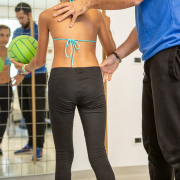Heath-related quality of life and functional outcomes in patients with congenital or juvenile idiopathic scoliosis after an average follow-up of 25 years: a cohort study
Heemskerk, Nienke W Willigenburg , Ben E E M J Veraart, Eric W Bakker, René M Castelein, Mark C Altena, Diederik H R Kempen
Spine J. 2023 Nov 28:S1529-9430(23)03503-9.doi:10.1016/j. spinee.2023.11.012.
Abstract
Background context: Congenital and juvenile scoliosis are both early-onset deformities that develop before the age of 10. Children are treated to prevent curve progression and problems in adulthood such as back pain and a decreased quality of life but literature on long-term outcomes remains scarce.
Purpose: To evaluate the health-related quality of life (HRQoL) and potential disability of children with congenital scoliosis (CS) or juvenile idiopathic scoliosis (JIS) after a minimum of 20 years follow-up.
Study design: Comparative cohort study.
Patient sample: A consecutive cohort of CS and JIS patients were retrospectively identified from a single-center scoliosis database. Patients born between 1968 and 1981 and treated during skeletal growth were eligible for participation.
Outcome measures: HRQoL (SF-36, SRS-22r, ODI).
Methods: The primary aim was to evaluate the HRQoL of CS and JIS patients using the general SF-36 questionnaire. Both patient cohorts were compared with age-matched national norms. The secondary aim was to analyze the differences between conservatively and surgically treated patients using the scoliosis-specific Scoliosis Research Society-22r questionnaire (SRS-22r) and the Oswestry Disability Index (ODI). T-tests were used for statistical comparison.
Results: In total, 114 patients (67% of the eligible patients) completed the questionnaire, with a mean follow-up of 25.5±5.5 years after their final clinical follow-up. Twenty-nine patients with CS were included with a mean age of 44.4±3.8 years (79.3% female), and 85 patients with JIS with a mean age of 43.7±4.2 years (89.4% female). Of the SF-36 domains, only the vitality score (60.6±18.0 for CS and 58.1±17.6 for JIS cohort) and mental health score (70.0±18.4 for CS and 72.1±18.1 for JIS cohort) were significantly lower compared with the general population (68.6±19.3 for vitality, and 76.8±17.4 for mental health). These decreased scores were larger than the determined minimum clinically important difference threshold of 4.37. Surgically treated JIS patients had a significantly lower score on the SRS-22r pain domain than their non-surgically treated peers (3.6±0.9 vs. 4.1±0.7l p=.019). Surgically treated CS patients had a significantly higher score on the SRS-22r mental health domain than their non-surgically treated peers (4.3±0.5 vs. 3.5±1.0; p=.023). No significant differences were found in the other domains.
Conclusions: Except for vitality and mental health domains, congenital and juvenile idiopathic scoliosis patients treated during skeletal growth had similar HRQoL on most SF-36 domains in adulthood compared with national norms. Surgical treated JIS patients experienced more pain compared with brace treated patients, while braced CS patients had a significantly lower mental scores compared with surgical treated patients. These long-term outcomes are essential to inform patients and can guide shared decision-making between clinicians and patients.
Keywords: Back pain; Brace; Bracing; Congenital scoliosis; EOS, early-onset scoliosis; HRQoL, health-related quality of life; JIS, juvenile idiopathic scoliosis; Long-term outcome; ODI, Oswestry Disability Index; QoL, quality of life; Refined SRS-22r; SF-36; Scoliosis Research Society 22-item Questionnaire; Surgery; Treatment.




Leave a Reply
Want to join the discussion?Feel free to contribute!